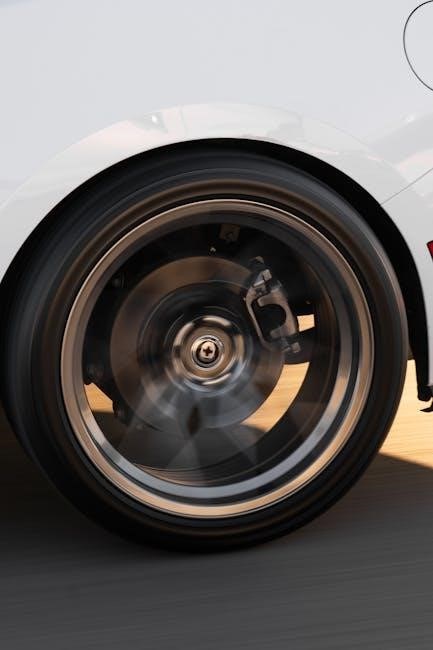The Ford Mustang’s manual gearbox, like the Getrag MT82, offers precise control and driver engagement, embodying the spirit of performance and heritage that defines the Mustang experience.
Overview of the Ford Mustang Manual Transmission
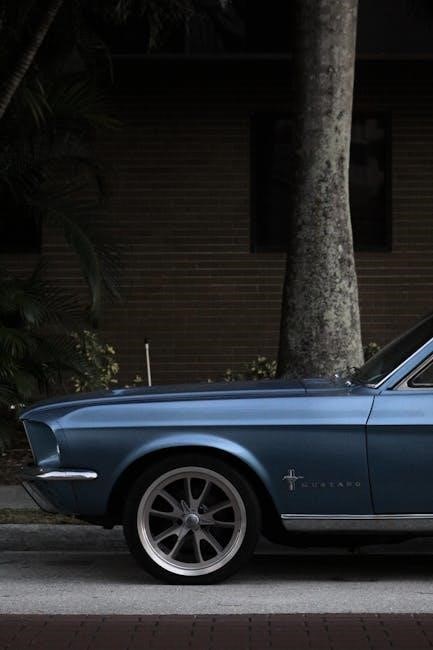
The Ford Mustang’s manual transmission, such as the Getrag MT82 six-speed, is designed for precision and durability. It features a robust gearbox with carbon synchronizers and a dual-mass flywheel, ensuring smooth yet firm shifts. The manual transmission is paired with a clutch system that provides a driver-focused experience, appealing to enthusiasts who value control and engagement. With a focus on performance, the manual gearbox allows for optimal acceleration and gear ratio selection, making it a preferred choice for both daily driving and track use. Its mechanical simplicity and driver interaction have made it a cornerstone of the Mustang’s heritage, offering a direct connection between the driver and the vehicle.

Importance of Manual Gearboxes in the Mustang Legacy
Manual gearboxes have played a pivotal role in shaping the Ford Mustang’s identity as a driver-centric performance car. They embody the spirit of enthusiast driving, offering a tactile connection between the driver and the vehicle. The Mustang’s legacy is deeply rooted in its manual transmissions, which have historically provided precise control and a sense of mechanical engagement. From the early 3-speed and 4-speed units to the modern Getrag MT82 six-speed, these gearboxes have become synonymous with the Mustang’s heritage. Enthusiasts often prioritize manuals for their ability to enhance the driving experience, making them a cornerstone of the Mustang’s appeal and a symbol of its enduring legacy as a performance icon.
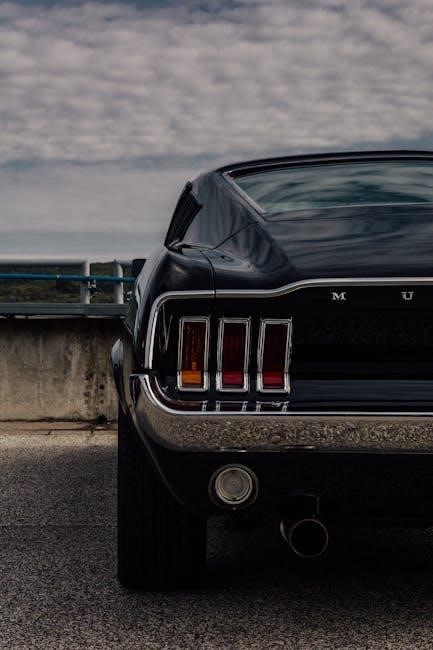
History of Manual Transmissions in the Ford Mustang
The Ford Mustang’s manual transmission history began with 3-speed and 4-speed units, evolving to the Getrag MT82 six-speed in modern models, reflecting its performance heritage.
Early Generations: 3-Speed and 4-Speed Manual Transmissions
The first Ford Mustangs featured a 3-speed manual transmission as standard, with an optional 4-speed manual for those seeking better performance. These early gearboxes were simple, durable, and designed to deliver a direct driving experience. The 4-speed, in particular, became synonymous with the Mustang’s identity, offering drivers more control over acceleration and gear changes. This setup allowed the Mustang to establish itself as a performance-oriented vehicle, catering to enthusiasts who valued the connection between driver and machine. The 3-speed and 4-speed transmissions laid the foundation for the Mustang’s reputation as a driver-focused car, emphasizing manual shifting as a core part of its appeal.
Evolution of the Manual Gearbox in the S550 Generation
The S550 generation marked a significant evolution in the Mustang’s manual gearbox, introducing the Getrag MT82 six-speed transmission. This gearbox offered improved gear ratios and smoother shifting compared to its predecessors. Designed to handle increased power outputs, the MT82 became a staple in the S550 lineup, particularly in performance-oriented models like the GT and EcoBoost. While some enthusiasts considered retrofitting the Tremec transmission for enhanced performance, the MT82 remained a reliable and capable option. Its durability and responsiveness made it a favorite among drivers who valued precision and control. The S550’s manual gearbox also saw advancements in materials and engineering, ensuring it could withstand the demands of both daily driving and track use.
The Getrag MT82 six-speed manual transmission was introduced in the S550 Mustang, offering a robust and refined shifting experience. Designed to handle higher torque outputs, the MT82 featured optimized gear ratios for both performance and efficiency. Its construction incorporated advanced materials to enhance durability, making it suitable for the Mustang’s powerful engine options. While some enthusiasts noted its potential for improvement, the MT82 became a reliable choice for drivers seeking a balance between daily driving comfort and track capability. Its introduction marked a step forward in the Mustang’s manual gearbox lineage, catering to a wide range of driving preferences and performance needs.
Current Models with Manual Gearbox Options
The 2025 Ford Mustang S650, Mustang Dark Horse, and GT/EcoBoost models offer manual gearbox options, catering to driving enthusiasts who value precision and control behind the wheel.
2025 Ford Mustang S650 with Manual Transmission
The 2025 Ford Mustang S650 offers a six-speed manual transmission, providing enthusiasts with precise control and an engaging driving experience. This model continues the legacy of the Mustang’s manual gearbox, combining modern performance with classic appeal. The manual transmission is paired with a range of engine options, including the powerful 5.0L V8, delivering exceptional acceleration and responsiveness. Drivers can enjoy the thrill of shifting gears while benefiting from the latest advancements in drivetrain technology. The S650’s manual gearbox is a testament to Ford’s commitment to preserving the driving experience that has made the Mustang iconic.
Mustang Dark Horse: A High-Performance Manual Option
The Mustang Dark Horse represents the pinnacle of performance with its manual transmission, offering a thrilling driving experience. Equipped with a powerful 500hp V8 Coyote engine, this model delivers exceptional acceleration and responsiveness. The six-speed manual gearbox enhances driver engagement, making it a favorite among enthusiasts. Priced around $76,000, the Dark Horse is a top-tier option for those seeking a high-performance pony car. Its exclusivity and potent capabilities make it a standout choice, blending power with precision. The manual transmission in the Dark Horse underscores Ford’s commitment to catering to driving purists who value the connection between driver and machine.
Mustang GT and Ecoboost Models with Manual Gearbox
The Ford Mustang GT and Ecoboost models offer manual transmission options, catering to driving enthusiasts. The GT features a 5.0-liter V8 engine paired with a six-speed manual gearbox, delivering 480 horsepower. The Ecoboost model comes with a 2.3-liter turbocharged engine and the same six-speed manual, providing a balance of power and efficiency. Both models are available in the 2025 lineup, with the GT starting at $71,990 and the Ecoboost priced similarly. These manual-equipped variants appeal to drivers who prefer precise control and a more engaging driving experience, making them standout choices in the Mustang lineup.

Manual vs. Automatic Transmission Debate
The debate centers on driving engagement and convenience. Manuals offer precise control and a connected feel, while automatics provide ease and, in some cases, faster acceleration.
Pros and Cons of Manual Transmission in the Mustang
The manual gearbox in the Ford Mustang offers a more engaging and connected driving experience, allowing drivers to have full control over gear shifts. It is lighter and more fuel-efficient compared to automatics. However, it requires more driver effort, especially in heavy traffic. The Getrag MT82 six-speed manual, while reliable, has known issues like clutch wear and the need for driveline coolers during track use. Enthusiasts appreciate the precision and performance, but others may find it less convenient. Balancing these factors, the manual transmission remains a popular choice for those prioritizing driving involvement and heritage over everyday comfort.
Why Enthusiasts Prefer the Manual Gearbox
Enthusiasts adore the manual gearbox for its tactile connection to the car, offering a sense of control and engagement that automatics can’t match. The ability to shift gears manually enhances the driving experience, making it more immersive and rewarding. For track use, a manual transmission allows precise control over acceleration and cornering, crucial for optimal performance. Additionally, the manual gearbox is lighter and more fuel-efficient, appealing to purists who value driving dynamics. The Mustang’s legacy as a performance icon is deeply tied to its manual transmissions, making them a symbol of authenticity and driver involvement for many enthusiasts.
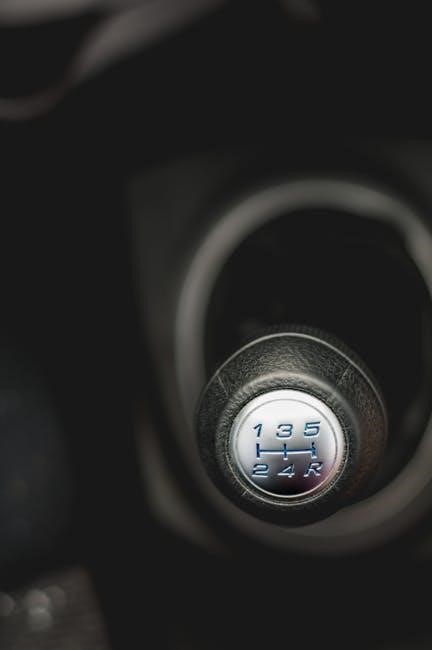
Performance Comparison: Manual vs. Automatic
The manual gearbox in the Ford Mustang offers a more engaging and responsive driving experience, with quicker acceleration and better control, especially in performance scenarios. Enthusiasts often prefer the manual for its ability to maximize the car’s potential, particularly on the track. While automatic transmissions provide convenience and ease, they can’t match the precision of manual shifting. The Getrag MT82 six-speed manual is praised for its smooth operation and direct feel, making it a favorite among drivers who value performance. However, automatics have closed the gap in acceleration times, with some models nearly matching the manual’s 0-60 MPH performance. For purists, the manual remains the choice for ultimate driver engagement and connection to the vehicle.
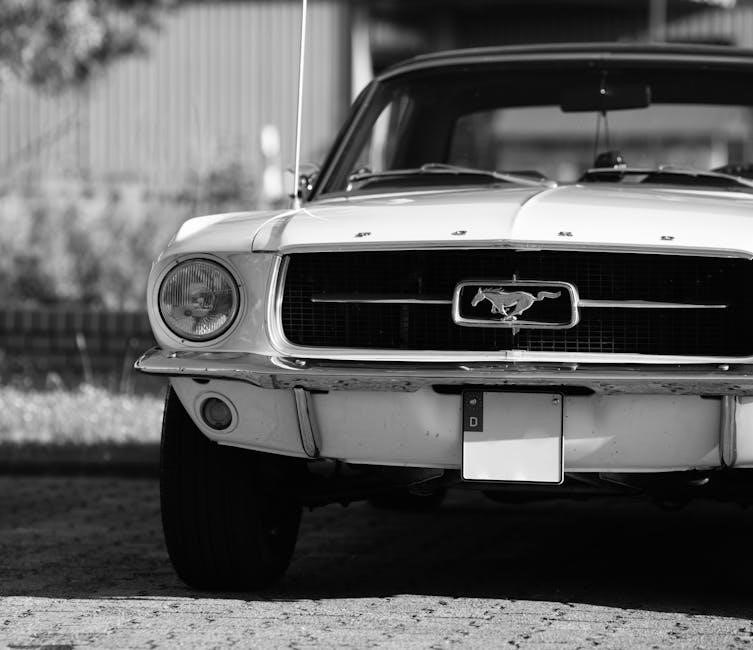
Performance and Handling with a Manual Gearbox
The manual gearbox enhances the Mustang’s driving dynamics, offering precise control and crisp shifts. It optimizes acceleration and handling, making it a preferred choice for spirited driving experiences.

Acceleration and 0-60 MPH Times with Manual Transmission
The Ford Mustang’s manual gearbox delivers exceptional acceleration, with the 2025 S650 achieving 0-60 MPH in 4.2 seconds. The Dark Horse model, equipped with a 5.0L V8, reaches 60 MPH in 4.2 seconds, while the GT model accomplishes it in 4.5 seconds. The Ecoboost model, with its 2.3L engine, achieves 0-60 MPH in 5.1 seconds. The manual transmission’s precise control and driver engagement enhance the overall performance, making it a preferred choice for enthusiasts seeking a dynamic driving experience.
Handling Benefits of a Manual Gearbox
The manual gearbox in the Ford Mustang enhances handling by providing direct driver control and a stronger connection to the vehicle. With precise gear shifts, drivers can optimize acceleration and deceleration, improving cornering precision. The S650 generation, equipped with a manual transmission, benefits from refined chassis tuning, offering sharper steering and better weight distribution. Additionally, the manual gearbox allows for better modulation of power delivery, reducing wheelspin and enhancing traction during aggressive driving. This level of control is particularly advantageous on track days, where the manual transmission’s responsiveness and driver engagement contribute to superior handling performance, making it a preferred choice for enthusiasts seeking a dynamic driving experience.
Driver Engagement and Control with Manual Shifting
Manual shifting in the Ford Mustang fosters a deeper connection between the driver and the vehicle, offering unparalleled control and engagement. The tactile experience of operating the clutch and gearshift creates a more immersive driving experience, allowing drivers to feel every nuance of the car’s performance. This direct interaction enables precise control over acceleration and deceleration, making it easier to optimize power delivery in various driving conditions. The manual gearbox, such as the Getrag MT82, provides a sense of mastery and satisfaction, as drivers can tailor their shifting technique to extract maximum performance. This level of engagement is a key reason why enthusiasts prefer the manual transmission, as it enhances the emotional and physical connection to the driving experience.
Maintenance and Common Issues
Regular maintenance is crucial for the Ford Mustang’s manual gearbox, with driveline coolers being essential for track use. Issues like clutch wear and Getrag MT82 problems can arise.
Common Problems with the Getrag MT82 Transmission
The Getrag MT82 six-speed manual transmission in the Ford Mustang has faced issues such as bearing wear and synchro damage, particularly under high-performance conditions. Drivers have reported difficulties with shifting smoothness over time, especially in track-driven vehicles. Additionally, the transmission’s cooling system can be insufficient for prolonged high-performance use, leading to overheating and potential damage. Regular maintenance, including fluid changes and driveline cooler upgrades, is essential to mitigate these issues. While the MT82 is durable for everyday driving, enthusiasts often recommend aftermarket upgrades for enhanced reliability and performance. Addressing these problems early can prevent costly repairs and ensure optimal transmission longevity.
Clutch Wear and Replacement in Manual Mustangs
Clutch wear is a common issue in manual Mustangs, particularly in high-performance driving scenarios. Symptoms include slippage, inconsistent engagement, and eventual failure. The stock Ford clutch in earlier S550 models has shown susceptibility to wear, especially under aggressive driving conditions. Replacement typically occurs between 30,000 to 50,000 miles, depending on usage. Recent recalls, such as the 2024 Mustang clutch issue affecting 8,161 units, highlight the importance of monitoring clutch health. Ford recommends regular inspections and adjustments to prevent premature wear. Enthusiasts often opt for high-performance clutch upgrades to handle increased power and torque. Proper driving techniques and maintenance can extend clutch life, ensuring smooth and precise shifting in the Mustang’s manual gearbox.
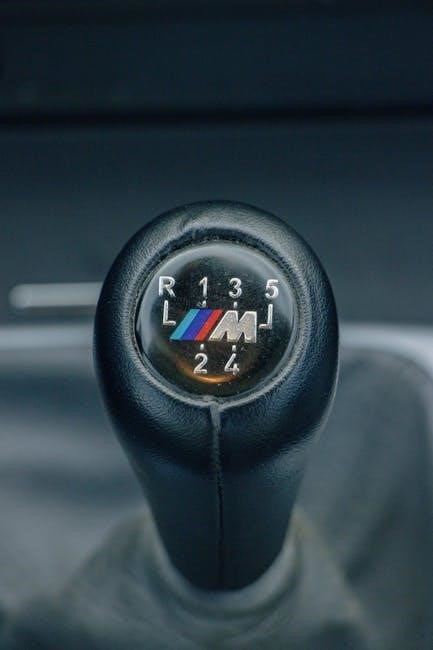
Importance of Driveline Coolers for Track Use
Driveline coolers are essential for maintaining optimal performance in track-driven manual Mustangs. Prolonged high-speed driving generates excessive heat, which can damage the transmission, differential, and other drivetrain components. Coolers help dissipate this heat, ensuring reliability and preventing overheating-related failures. The Mach 1, for instance, comes equipped with a comprehensive cooling system, making it more track-ready straight from the factory. Enthusiasts often upgrade or add auxiliary coolers to handle the demands of aggressive driving. Proper cooling systems not only protect the driveline but also enhance the car’s overall performance and longevity, making them a critical investment for serious track use.
Upgrading and Aftermarket Support
The Ford Mustang’s manual gearbox can be enhanced with aftermarket upgrades, such as transmission swaps and driveline coolers, improving both track performance and overall durability significantly.
Aftermarket Transmission Upgrades for the Mustang
Aftermarket transmission upgrades for the Ford Mustang manual gearbox are popular among enthusiasts seeking enhanced performance. Options like the Tremec TR-3160 or TR-9060 offer increased strength and reliability, especially for high-torque applications. These transmissions are often favored for their durability and smooth shifting, making them ideal for track use or high-performance driving. Additionally, driveline components such as lightweight flywheels and high-performance clutches can be installed to improve acceleration and reduce heat buildup. These upgrades not only enhance the driving experience but also ensure longevity under demanding conditions. For those looking to maximize their Mustang’s potential, aftermarket transmission upgrades provide a robust solution.
Clutch Upgrades for High-Performance Driving
Clutch upgrades are essential for high-performance driving in the Ford Mustang, particularly for track use or aggressive driving. The stock clutch in earlier S550 models, such as the Getrag MT82, can show wear under heavy use. Upgrading to a high-performance clutch, such as a ceramic or multi-plate unit, improves durability and heat resistance. These clutches are designed to handle higher torque levels and repeated high-RPM shifts, ensuring consistent performance. Additionally, lightweight flywheels can be paired with upgraded clutches to reduce inertia and improve acceleration. For enthusiasts pushing their Mustangs to the limit, a performance clutch upgrade is a critical modification to maintain reliability and enhance driving dynamics.
Installation of Limited-Slip Differentials
Installing a limited-slip differential (LSD) in the Ford Mustang enhances traction and stability, particularly during high-performance driving. The LSD ensures smoother torque distribution between the rear wheels, reducing wheelspin and improving cornering precision. This upgrade is especially beneficial for track use, where consistent grip and control are critical. The LSD works seamlessly with the manual gearbox, allowing drivers to maintain better connection with the road. For enthusiasts seeking to maximize their Mustang’s potential, an LSD installation is a key modification. It complements the manual transmission’s direct control, offering a more responsive and engaging driving experience. This upgrade is highly recommended for those pushing their Mustangs to the limit on the track or twisty roads.
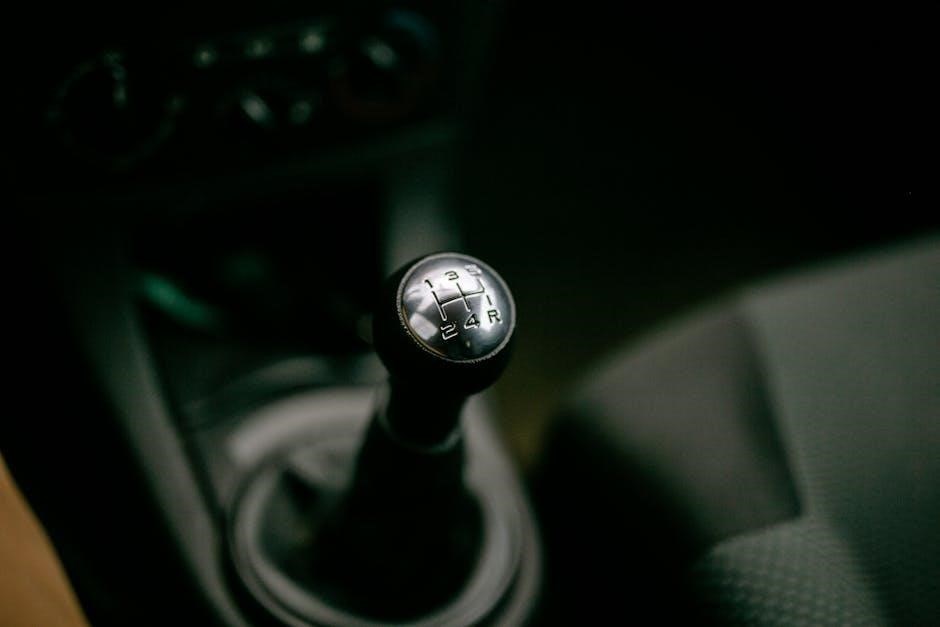
Future of Manual Transmissions in the Ford Mustang
Ford remains committed to offering manual transmissions in the Mustang, catering to enthusiast demand. Hybrid and electric models may integrate manual-like experiences, ensuring driver engagement endures.
Rumors About the Next-Generation Manual Gearbox
Rumors suggest Ford is developing an advanced manual gearbox for future Mustangs, potentially integrating hybrid or electric components while retaining driver engagement. The Tremec transmission, praised for its durability and cooling capabilities, may inspire next-gen designs. Enthusiasts speculate about improved shifting precision and torque capacity to handle high-performance engines. Additionally, there is talk of addressing past issues like clutch wear and driveline overheating, possibly through enhanced cooling systems. While details are scarce, Ford’s commitment to manual transmissions indicates a focus on blending tradition with innovation. The next-generation gearbox could redefine the balance between performance and practicality, keeping the Mustang a favorite among driving purists.
Hybrid and Electric Mustangs: Will Manual Survive?
As Ford explores hybrid and electric powertrains for the Mustang, questions arise about the future of manual transmissions. While the S650 generation still offers a manual option, electrification poses challenges. Enthusiasts worry that automation might dominate, but Ford has hinted at preserving driver engagement. Rumors suggest a dual-clutch system or hybrid-specific manual gearbox could emerge, blending tradition with innovation. The Getrag MT82’s legacy and the demand for tactile driving experiences may influence Ford’s decisions. Community support remains strong, with many hoping manual transmissions adapt rather than disappear. The balance between progress and heritage will shape the Mustang’s identity in an electric era.
Community Support and Demand for Manual Transmissions
The Ford Mustang community remains a strong advocate for manual transmissions, with enthusiasts emphasizing the tactile driving experience and connection to the car’s heritage. Forums and social media highlight a passionate demand for manual options, even as automation grows. Ford has responded by retaining manual gearboxes in performance models like the Dark Horse, showing a commitment to driver engagement. Enthusiasts often modify and upgrade their manual transmissions, supported by a robust aftermarket. This dedication ensures that manual transmissions remain relevant, even as the industry shifts toward electrification. The community’s vocal support plays a crucial role in shaping Ford’s decisions, keeping the manual gearbox alive for future generations;
The Ford Mustang manual gearbox remains a symbol of driving purity, cherished by enthusiasts. Its legacy endures, blending tradition with modern performance, ensuring a bright future for manual transmissions.
Final Thoughts on the Ford Mustang Manual Gearbox
The Ford Mustang manual gearbox embodies the essence of driving connection, offering unparalleled control and engagement. With models like the S650 and Dark Horse, the manual transmission remains a cornerstone of the Mustang’s identity. While automatics offer convenience, the manual gearbox delivers a raw, tactile experience that enthusiasts crave. The Getrag MT82 and Tremec transmissions highlight Ford’s commitment to performance and heritage. Maintenance, such as clutch replacements and driveline coolers, ensures longevity for track enthusiasts. As the automotive world evolves, the manual gearbox’s future hinges on community support and Ford’s dedication to preserving driver involvement. The Mustang manual gearbox is more than a transmission—it’s a symbol of automotive passion and tradition.
Legacy and Future Prospects of Manual Transmissions
Manual transmissions have long been a cornerstone of the Ford Mustang’s identity, symbolizing driver engagement and performance heritage. From the early 3-speed and 4-speed units to the modern Getrag MT82 and Tremec gearboxes, manual transmissions have evolved to meet the demands of enthusiasts. While automatics dominate the market, the manual gearbox remains a cherished option, especially in high-performance models like the Dark Horse. Looking ahead, rumors suggest Ford may introduce advanced manual transmissions, potentially hybrid or electric, to maintain driver connection. Community demand and Ford’s commitment to performance ensure the manual gearbox will endure, even as the automotive landscape shifts toward electrification and automation.
